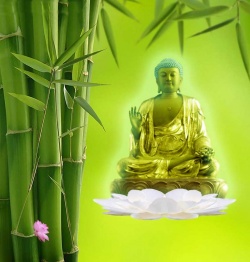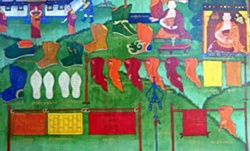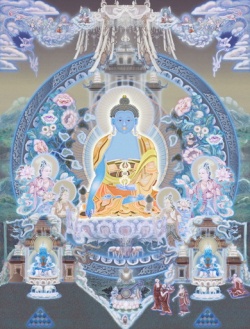Manjushri mantra
With a diacritic font installed, the mantra is transliterated thus:
Manjushri is a Bodhisattva who represents wisdom, and his mantra also symbolizes that quality. He holds a sword in his right hand — symbolizing his ability to cut through delusion. In his left hand, by his heart, he holds the stem of a lotus flower, which bears a book — the Perfection of Wisdom teaching, or Prajnaparamita.
Om is a mystical syllable (see Om Shanti Shanti Shanti for more details).
The syllables between Om and the concluding Dhiih are the first syllables of a syllabary called the arapacana because it begins with
A RA PA CA and NA. (A syllabary is like an alphabet, but made up of syllables).
This syllabary is found in a number of Buddhist texts, including some Perfection of Wisdom (prajñaparamita) texts.
Many of the texts in which A RA PA CA NA (and the rest of the sylllabary) appears are not connected with Manjushri, but according to Dr. Conze (in the introduction to The Large Sutra on Perfect Wisdom) “in later literature is is always connected with the Bodhisattva Manjushri.”
The individual syllables A RA PA CA and NA have no conceptual meaning, although they are seen as having symbolic connections with various spiritual qualities.
Here’s the schema laid out in the Large Sutra of Perfect Wisdom (adapted from Conze):
A leads to the insight that the essence of all things is unproduced.
RA leads to the insight that all things are pure and free of defilements.
PA leads to the insight that all dharmas have been “expounded in the ultimate sense.”
CA leads to the insight that the arising and ceasing of things cannot be apprehended because in reality there is no arising or ceasing.
NA leads to the insight that although the names for things change the nature of things behind their names cannot be gained or lost.
These are all important concepts in the Perfection of Wisdom, although to say they are concepts is a bit limiting — really they’re attempts to describe the indescribable nature of reality.
Dhiih is defined as meaning:
thought , (especially) religious thought , reflection , meditation , devotion , prayer; understanding , intelligence , wisdom
You who are the perfect, youthful body, whose flame of wisdom blazes and dispels the darkness of worldly ignorance: I prostrate before you and praise you, Manjushri.
OM WA GHI SHWA RI MUM'Bold text
To realize all the sutras and commentaries, please grant me the power of radiant wisdom.
By the light of your wisdom, Compassionate One, may the darkness of ignorance in my mind be dispelled.
Short Practice in Tibetan
SHON NU’I KU LU CHANG WA PO
YE SHE DRON ME RAB TU BAR
JIG TEN TI MUG MUN SEL WA
JAM PEL YANG LA CHAG TSEL TO
OM WA GHI SHWA RI MUM
TSE DEN KYO KYI KHYEN RAB WO SER GYI
DAK LO’I TI MUG MUN PA RAB SEL NE
KA DANG TEN CHO HUNG LUG TOG PA YI
LO DRO POB PA’I NANG WA TSEL DU SOL




